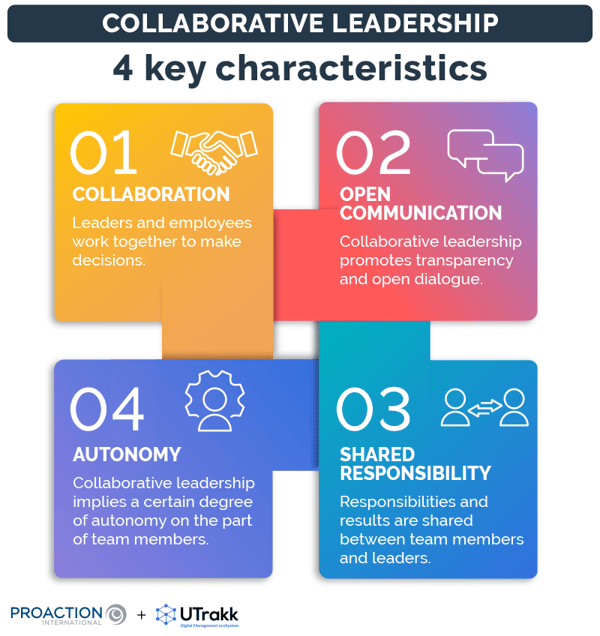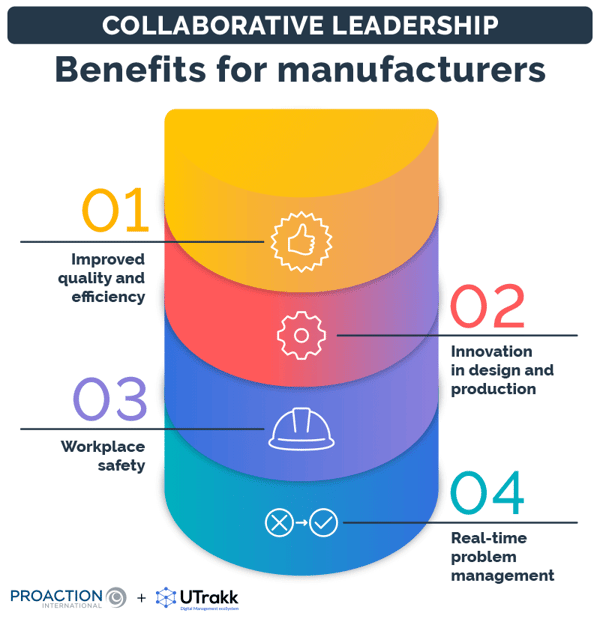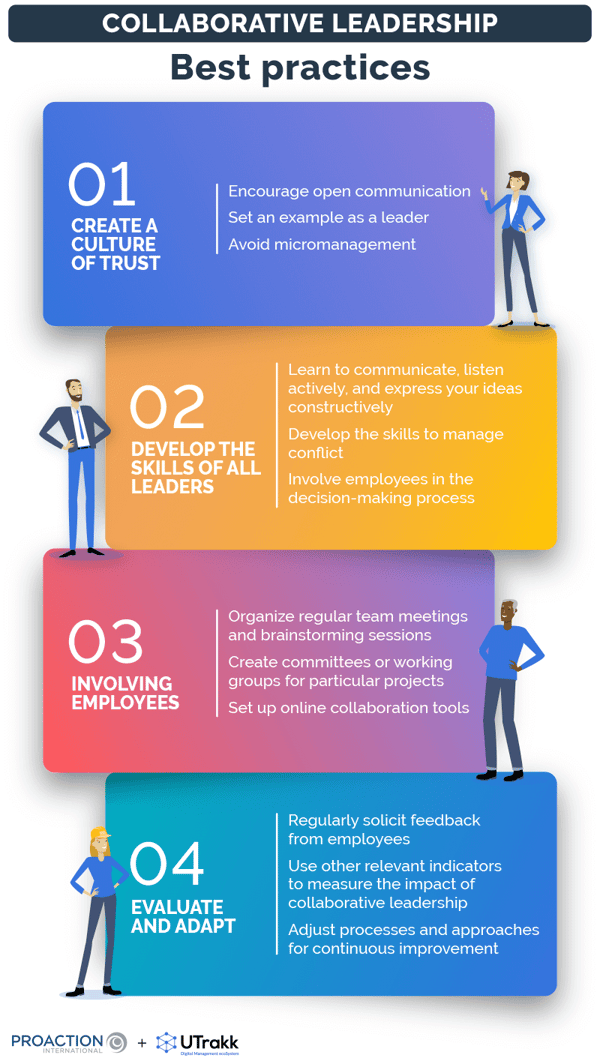What does collaborative leadership mean and what are its characteristics?
Collaborative leadership (also known as participative or democratic leadership) is a management model in which leaders actively invite their employees to take part in the decision-making and problem-solving process. They democratically seek consensus, decentralizing their power.
Unlike the authoritarian leadership style, where most decisions happen at the top of the hierarchy, collaborative leaders are team-oriented. They encourage employee involvement at all levels of the organization.
4 key characteristics of the collaborative leadership approach

- Collaboration: Collaboration skills are essential in this management practice. Collaborative leaders and their employees work together to make decisions and achieve common goals. This type of leadership emphasizes the active participation and involvement of every employee. It creates an inclusive environment where individuals can bring valuable and unique experience, skills, and perspectives.
- Open communication: Collaborative leadership promotes transparency and open dialogue. It encourages team members to ask questions, express their concerns about a given situation, and contribute ideas and recommendations.
- Shared responsibility: Responsibilities and results are shared between team members, reinforcing a sense of belonging, accountability, and commitment. Collaborative leaders recognize collective successes and take responsibility for mistakes or failures instead of blaming their employees.
- Autonomy: Collaborative management implies a certain degree of autonomy of the team members. Leaders actively engage employees in decision making and problem solving ‒ to a certain extent. However, autonomy does not mean abandonment. Collaborative leaders remain responsible for the company's overall vision and long-term objectives.
Examples of collaborative leadership
There are many examples of well-known companies that have successfully adopted collaborative leadership practices. Here are 5 examples:
- At Google, employees are encouraged to devote 20% of their time to personal projects, fostering creativity and innovation.
- Toyota has implemented the Kaizen continuous improvement system, enabling every member to suggest improvements and solutions to production problems.
- Outdoor clothing company Patagonia invites employees to participate in social and environmental initiatives, strengthening commitment and cohesion.
- Online retailer Zappos, a subsidiary of Amazon, lets every team member contribute to the company's decision making and organizational planning.
- Burt's Bees, a personal care product company, encourages employee participation in product development and defining the company values.
Why is collaborative leadership important?
According to several studies carried out by the global research company Gallup:
- 51% of currently employed workers say they are looking or actively looking for a new job.
- 70% of team engagement is influenced by managers.
These statistics show that the way you manage your company and your employees is very important to retain valuable talent and keep your workforce engaged (and performing). Offering leadership that meets your employees’ needs is critical.
The collaborative style is a real strength and adds tremendous value. It makes a big difference in the workplace on many levels.
Employee engagement
Employees feel valued, motivated, and engaged when they are included in the decision-making process. It leads to greater job satisfaction, better talent retention, and even higher customer satisfaction (which brings increased sales).
Creativity and innovation
Everyone has something to contribute. A collaborative leader encourages diverse perspectives and ideas, fostering creativity and innovation.
Adaptability
Employees are more likely to accept change when they can contribute to implementing that change. Collaborative leadership, therefore, offers greater adaptability.
Improved productivity
Employees are more likely to be invested in achieving objectives when they have helped to set them. What's more, if you combine higher engagement, creativity, innovation, and better use of skills, you get a solid boost in productivity.
What are the challenges for collaborative leaders?
While collaborative leadership has many benefits, it also has a few challenges.
First, it can slow down decision making. Collaboration often takes longer than authoritarian decision making, which can be a problem when urgent decisions need to be taken.
A collaborative leader may also see resistance to change from some of their employees accustomed to an authoritarian leadership style.
Finally, collaboration can sometimes lead to disagreements, requiring compromise, finding common ground, and knowing how to manage conflict effectively.
Collaborative leadership in manufacturing
On top of its positive influence in office work settings, collaborative leadership also plays a significant role in manufacturing, bringing industry-specific benefits such as:

- Improved quality and efficiency: Collaborative leadership enables employees to actively find innovative solutions to improve quality, reduce waste, optimize production processes, and solve problems quickly.
- Innovation in design and production: This leadership type encourages workers to suggest new ideas in product design and manufacturing processes.
- Workplace safety: By involving employees in safety-related decision making, companies can identify and mitigate risks more effectively.
- Real-time problem management: A collaborative leader encourages employees to report problems to the manager immediately and to work as a team to solve them.
What are the qualities of a collaborative leader?
Certain qualities are essential to demonstrate collaborative leadership and reap the rewards of this type of management.

Communication skills
Communicating clearly and effectively is crucial to conveying objectives, expectations, and information. Ask open-ended questions, express yourself sympathetically, and remember to give constructive feedback to employees.
Active listening
You need to be an attentive listener to better understand your employees' needs, concerns, and ideas. Give everyone a chance to express themselves and be heard.
Empathy
Understanding the emotions and motivations of your team members is essential to building solid relationships, reinforcing their willingness to cooperate, and maintaining their morale. Work on your sense of empathy and emotional intelligence.
Transparency
Being open and honest in your interactions with employees helps create an environment of mutual trust. Share relevant information about the company's decisions, objectives, and vision.
Adaptability
As a collaborative leader, you must be flexible and open to new ideas and changes. Be ready to adjust plans and decisions according to team input.
Managing conflict
The collaborative management style can sometimes lead to disagreements within the team. You need to be able to facilitate conflict resolution.
How to implement collaborative leadership
Here are the various steps to follow and effective methods for implementing collaborative leadership over the long term and benefiting from this valuable management style:

1. Create a culture of trust
Start by establishing a climate of trust in your entire company. Employees must feel safe and comfortable sharing their opinions, ideas, and concerns.
Best practices:
- Encourage exchanges by setting up the proper communication channels (regular meetings, suggestion boxes, anonymous feedback, etc.). Be open to receiving feedback.
- Set an example as a leader by being transparent and honest. Share decisions with your team and take concrete actions to execute them.
- Avoid micromanagement. Give your employees the autonomy they need to make decisions and solve problems on their own.
2. Develop the skills of the leadership team
The success of collaborative management depends on your ability to lead… collaboratively! Targeted training and coaching sessions will help you develop the specific skills required to nail this type of leadership.
Best practices:
- Learn how to communicate, actively listen, ask open-ended questions, and express your ideas constructively.
- Develop the skills needed to manage conflict and find solutions that all people involved agree with.
- Involve employees in the decision-making process while focusing on the company's objectives.
3. Involve employees
For collaborative leadership to work effectively, it's crucial to define clear processes that will enable employees to contribute to company decisions and initiatives.
Best practices:
- Organize regular team meetings and brainstorming sessions during which employees from different departments can share their ideas and perspectives.
- Create committees or working groups for specific projects or activities that include employees.
- Implement online collaboration tools (instant messaging, video calls, etc.) to facilitate participation and create a strong team spirit. This is of the utmost importance if you have remote employees working in different time zones.
4. Evaluate and adapt
Collaborative leadership is a dynamic approach that requires constant evaluation and adjustments based on results.
Best practices:
- Regularly ask feedback from employees on how collaborative processes are working and what they think about the decisions made.
- Use relevant key indicators to measure company performance and employee satisfaction.
- Based on KPIs and feedback, continually adjust processes and approaches to improve collaborative leadership.
How coaching helps transform your management style to become a collaborative leader
Even if you've fully grasped the basics of this leadership style, it can be beneficial to call on the services of a coach to become the best collaborative leader possible. An expert coach can be essential in this transformation, guiding you throughout the process and accelerating organizational change.
The action points of a coach:
- They ensure that collaborative leadership aligns with your company's vision, values, and objectives.
- They help you acknowledge your current leadership style, your strengths and weaknesses.
- They provide tools and techniques to help you develop specific collaborative leadership skills.
- They help you develop a strategic plan for implementing collaborative leadership in your organization.
- They offer individual, personalized support to help you overcome the challenges of transitioning to a collaborative leadership style.
- They give you constructive feedback on your behavior and actions so that you can continuously improve.
- They can serve as a model of collaborative leadership, showing you how to practice the principles of this type of management.
Driving innovation and growth through collaboration and leadership
Collaborative leadership helps foster collaboration, innovation, and employee engagement. Although this management style has challenges, its foundation on teamwork and team productivity makes it a wise choice for you as a business leader.
By developing the required qualities and skills, building a culture of trust, involving your employees, and adjusting practices along the way, you can practice collaborative leadership and create a positive environment where employees feel valued and ready to do their best work.
With its focus on collaboration and people, collaborative leadership is part of Industry 5.0’s best practices and contributes to the company's long-term success.








